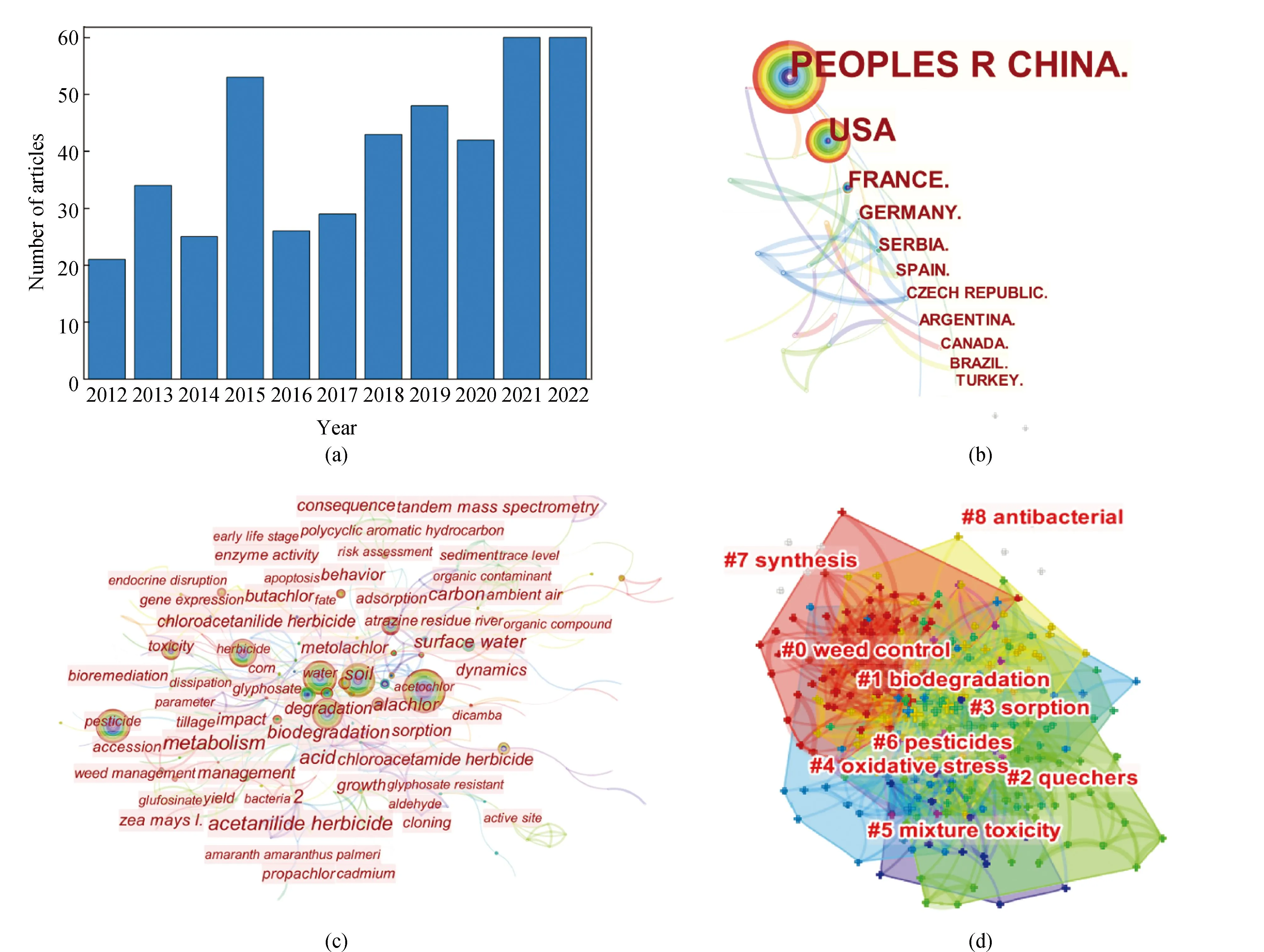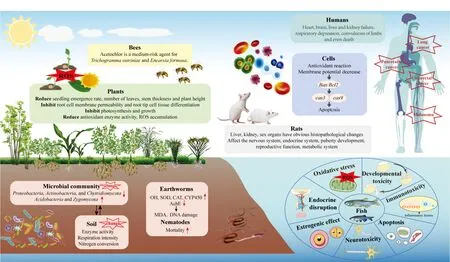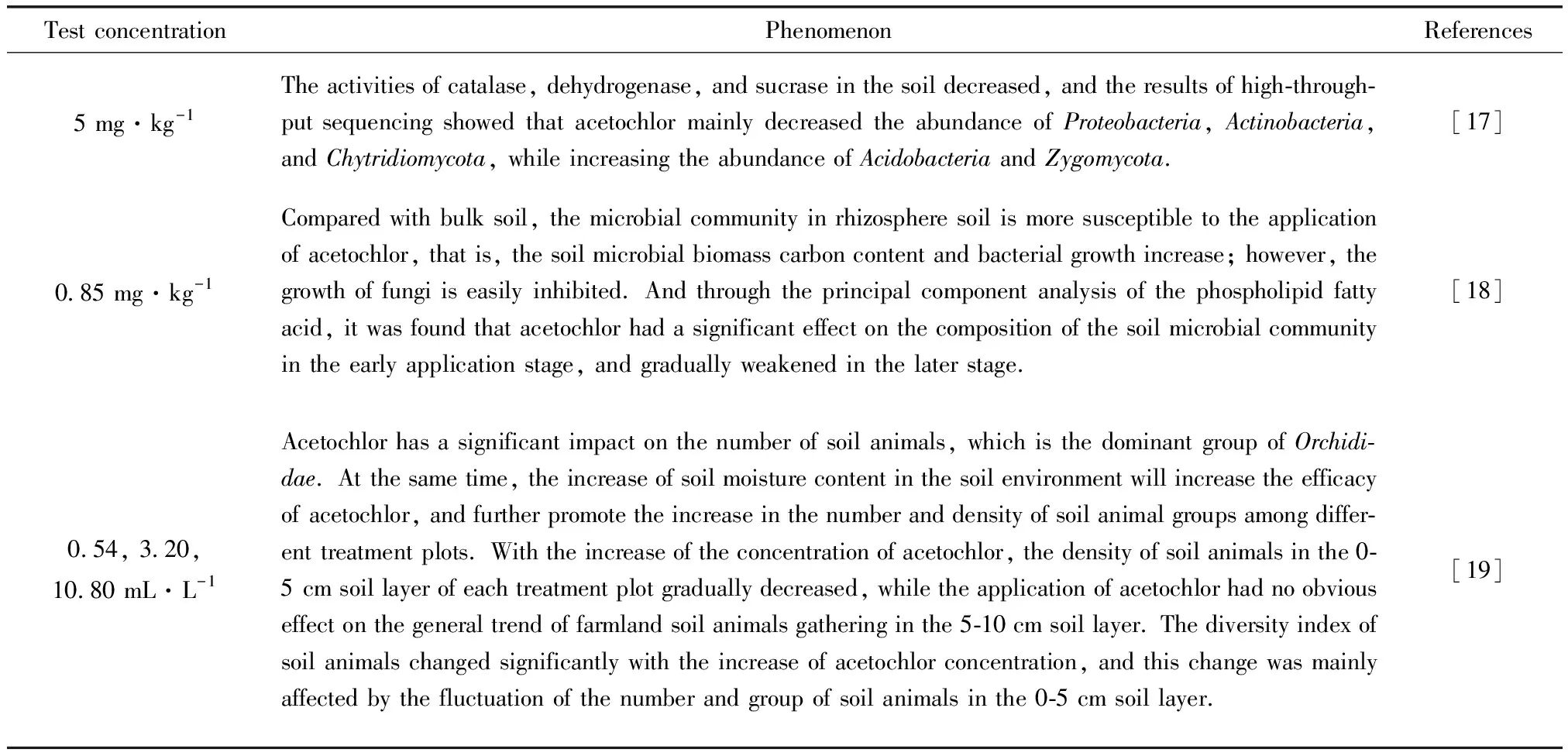Double-edged sword acetochlor:Status and challenges of toxicology
JIAO Ya-Qi,JIA Jun-Xin,WANG Sa,LI Hui,GAO Jin-Sheng,LI Li,*
(Heilongjiang University a.Postdoctoral research workstation of Heilongjiang Pesticide Engineering Technology Research Center;b.College of Advanced Agriculture and Ecological Environment,Harbin 150086,China)
Abstract:This paper examines the environmental and ecological impacts of the widely used pre-seedling herbicide acetochlor in agriculture. A comprehensive scientific review on acetochlor toxicity studies from 2012-2022 was conducted using CiteSpace 5.7 R2 software. The detrimental effect of acetochlor on non-target organisms has been widely documented,including soil,plants,aquatic and terrestrial organisms,and even humans. The toxic effects on organisms are attributed to its binding with antioxidant enzymes through hydrophobic interactions and hydrogen bonds,leading to excessive ROS accumulation and activation of toxic pathways. Integrating the existing literature on acetochlor environmental effects,this review identifies challenges and offers solutions for acetochlor in the environment and sustainable development. It also provides a theoretical framework for solving ecological environmental stability issues.
Key words:acetochlor;toxic effect;ROS;CiteSpace
0 Introduction
Organic pollutants,including polycyclic aromatic hydrocarbons (PAHs),organic pesticides (OPs),polychlorinated biphenyls (PCBs),polybrominated diphenyl ethers (PBDEs),endocrine disruptors (EDCs),pharmaceuticals,and personal care products (PPCPs),have exacerbated the degradation of farmland soil environmental quality and reduced the stability of farmland ecosystems. Herbicides,which are a component of OPs,have increasingly been used to enhance agricultural productivity and crop yields,thus exerting significant impacts on farmland ecosystems[1]. Acetochlor,a high-efficiency herbicide with the full name of 2-chloro-N-(ethoxymethyl)-N-(2-ethyl-6-methylphenyl)acetamide (C14H2OClNO2),primarily penetrates weeds cell through shoots or roots upon topsoil application,leading to weed death through inhibition of cells division[2-3]. According to the United States Environmental Protection Agency (USEPA),acetochlor is ranked as the third most commonly utilized herbicide in the agricultural market,with an estimated usage of 30-35 million pounds in 2001. Furthermore,it is widely employed in China,where annual usage surpasses 100 000 tons.Continuous application of acetochlor leads to its gradual resistance to microbial degradation in environmental microorganisms,thereby maintaining stable activity in the environment. Consequently,the residual amount of acetochlor and its degradation products is widely present in the environment,classifying them as persistent organic pollutants[1,4]. The exceptional structural stability and water solubility of acetochlor enable its easy infiltration into soil and water,persisting in ecosystems for extended periods,creating health risks for non-target organisms and humans[5]. Acetochlor has been identified as a suspected endocrine disruptor in a variety of vertebrates by the USEPA and the European Union (2010)[4]and classified as a potential human carcinogen[6]. However,there is still a lack of systematic statistics and comprehensive analysis on the toxicity of acetochlor.
CiteSpace 5.7 R2 software was employed to perform a comprehensive scientometric analysis of literature accumulated over the past decade. The software was utilized to analyze the co-occurrence network of countries and keywords,thus delineating recent research trends (Fig.1)[7]. The study observed a consistent annual increased in research on acetochlor,which was found to be closely associated with the agricultural levels of different countries,notably China,the United States,and France serving as the primary contributors to acetochlor research publications. Notably,toxicology and remediation emerged as influential research domains within this field,and analysis revealed extensive research activity in these areaas over the past decade. Thus,this review conducted a literature search using Web of Science (www.isiwebofknowledge.com/),Google Scholar (https://scholar.google.co.kr),and Science Direct (https://www.sciencedirect.com/)to analyze the toxicity of acetochlor to organisms. This review highlights the current understanding of acetochlor toxicity in the environment,while also identifying literature gaps. These findings can serve as valuble references for future research endeavors.

Fig.1 (a)Number of publications related to acetochlor research over the past decade. Based on the analysis conducted using Citespace software,researches on acetochlor over the past decade;(b)country analysis;(c)keyword analysis;(d)keyword cluster analysis
1 Toxic effects of acetochlor
Acetochlor is widely used in farmland,leading to its release into different environmental systems. Therefore,research has been conducted on the toxicity of acetochlor in soil,water and air,with a predominant focus on its impact on vertebrates,invertebrates,plants,microorganisms,and other organisms (Fig.2). Due to the sensitivity of organisms to pollutants,diverse organisms are selected for ecotoxicological studies,enabling the development of standardized procedures to interpret results and facilitate comparisons with other studies.

Fig.2 Environmental effects of acetochlor
1.1 Toxic effects of acetochlor in the air on organisms
Considered as a peril to the health of living organisms,air pollutant exerts a strong influence as air-borne pollutants can directly infiltrate the respiratory system,reaching the alveoli[8]. Xu et al.[3]found that during pesticides spraying,some pesticides exhibit a drifting effect that specifically impact on natural enemy insects. For instance,acetochlor moderately endangersTrichogrammaostriniaeandEncarsiaformosa. Therefore,the widespread application of chemical pesticides not only significantly hampers the control efficacy of using natural enemies for pest management but also disrupts ecological balance.
1.2 Toxicity to the soil environment
1.2.1 Toxicity of acetochlor to soil
Acetochlor’s weed control may impact the soil ecosystem. Acetochlor exposure can significantly alter soil enzyme activities (phosphatase,polyphenol oxidase,catalase,soil urease),respiration intensity[9-11],and nitrogen conversion[12-15]. Especially,changes in soil-related physiological indicators can influence the composition of soil microbial communities (Table 1). Maintaining proper soil microbial community structure and diversity is crucial for the sustainability and productivity of soil ecosystems[16]. Hao et al.[17]found that the recommended field dose of acetochlor (5 mg·kg-1)reduced the activities of catalase,dehydrogenase,and invertase in the soil. High-throughput sequencing results showed a decrease in the abundance ofProteobacteria,Actinobacteria,andChytridiomycota,while an increase in the abundance ofAcidobacteriaandZygomycotadue to acetochlor. Bai et al.[18]discussed the effect of acetochlor on microbial biomass and community structure in both rhizosphere and bulk soil after one month of application. It was found that the rhizosphere microbial community showed higher susceptibility to acetochlor compared to the bulk soil,resulting in increased soil microbial biomass carbon content and bacterial growth,along with unhibited fungal growth. Through principal component analysis of the phospholipid fatty acid,it was determined that acetochlor significantly affected the composition of the soil microbial community in the early application stage,with a diminishing effect in the later stage. Moreover,acetochlor exposure also lead to affect significant changes in the abundance of suborders within the dominant group of soil animals in farmland[19]. In summary,acetochlor application affects soil health and disturbs soil microflora. However,disruptions in the microbial community can,in turn,affect soil fertility and quality,leading to adverse effects on plant growth and yields.

Table 1 Effects of exposure to acetochlor on soil environment
1.2.2 Acetochlor toxicity in plants
Table 2 depicts the toxic effect of acetochlor on plants. In general,the normal field application rate of acetochlor may not adversely affect the growth of plants likeScutellariabaicalensisgeorg,peas,corn,and soybeans[20-24]. However,prolonged or excessive spraying may result in toxic effects. Li et al.[25]and Gao[26]found that exposure to high concentrations of acetochlor had an impact on wheat root cell membrane permeability,antioxidant enzyme activity,and root tip cell tissue differentiation[27]. Importantly,prolonged acetochlor application can reduce the emergence rate,leaf number,stem thickness,and plant height of peanut and soybean seedlings,significantly restricting their growth. Acetochlor can also significantly reduce the antioxidant enzyme activity in plants. Over 12 years,continuous application of acetochlor led to decreased yields of peanuts and soybeans,with the decline in yield escalating as the application years increased[28]. Certain plants,like rice,Chuzhou chrysanthemum seedlings (DendranthemamorifoliumL.),pumpkins,grapes,and sorghum are not treated with acetochlor as an herbicide. Exposure to acetochlor during the growth of these plants can induce envident toxicological effects. It diminishes plant antioxidant enzyme activity,leading to ROS accumulation,and subsequently inhibiting germination,root vitality,photosynthesis,and growth,causing significant plant damage and yield reduction[29-35]. Clearly,exposure to acetochlor can have varying degrees of impact on plant health. Considering the harm acetochlor inflicts on the soil,it is reasonable to surmise its impact on plants damage. Moreover,alterations in the soil environment can indirectly influence plant growth beyond the direct toxic effects.
1.2.3 Acetochlor toxicity in soil organisms and nematodes
Pesticides directly affect non-target soil organisms,including environmental engineer earthworms in the soil (Table 3). Earthworms typically serve as favored food sources for amphibians,reptiles,birds,and mammals. As a result,the presence of pesticides poses a potential risk for biomagnification effects[36]. Wang et al.[37-38]investigated the acute toxicity of numerous commonly used herbicides toEiseniafetida,revealing high and moderate toxicity of acetochlor to earthworms. Acetochlor can significantly increases the hydroxyl radical (·OH-) content,superoxide dismutase (SOD),and antioxidant enzyme catalase (CAT)activities,as well as cytochrome P450 content in earthworms. It also considerably inhibits acetylcholinesterase (AchE)activity,leading to lipid peroxidation and DNA damage[39]. Furthermore,comprehending the availability and susceptibility of nematodes in toxicity testing can enhance the impact of harmful substances on soil ecosystem health. Nevertheless,exposure to acetochlor can impact the mortality,growth,and reproduction of soil nematodes likeCaenorhabditiselegansandPristionchuspacificus[40].
In summary,acetochlor exposure can directly impact soil enzyme activities and microbial community structure,and directly and indirectly influence plant growth,as well as the health of earthworms and nematodes. It can be seen that the disorder of the antioxidant system is the main cause of harm to animals and plants. Furthermore,in the soil environment,while acetochlor spraying effectively eliminates weeds,its toxic effects on the soil environment should not be disregarded.
1.3 Toxic effects of acetochlor on aquatic organisms
Acetochlor has been identified as the predominant contributor to the projected chronic pesticide toxicity index in fish[41]. Zebrafish is commonly utilized as a model aquatic animal to assess the toxicological impact of substances,The 96 h-LC50 values of acetochlor on zebrafish embryos,larvae,juveniles,and adults were found to be 5.82,1.34,3.00,and 1.44 mg·L-1,correspondingly[42]. According to the classification standards outlined by the Scientific Issues of Marine Environmental Protection,the ecotoxicological risk of acetochlor to zebrafish is considered moderately toxic[43]. Acetochlor exposure can lead to reduced hatching rate,induction of pericardial cyst edema,bradycardia,circulatory defects,thrombosis,sac closure,trunk bending,and other symptoms in zebrafish embryos (Table 4). Circulatory disturbances induced by bradycardia may lead to thrombus formation. In addition,the down-regulation of Nkx2.5 and Gata4,associated with cardiac procedures induction,may underpin the cardiovascular toxicity of acetochlor in zebrafish[44-45]. Studies of Hu et al.[46]and Xu et al.[47]further confirmed additional other toxic effects of acetochlor. Specific toxic mechanisms are evident in zebrafish genes involved in oxidative stress (CAT,GPX,GPX1a,Cu/Zn-SOD,andOgg1),the hypothalamic-pituitary-gonad/thyroid (HPG / HPT)axis (asd1,dio1,dio2,tpo,trα,trβ,s1c5a5,crh,tsh,VTG1,ERβ1,CYP19a,ugt1ab,ttr),apoptosis pathway (Bcl2,Bax,P53,andCas8),and innate immunity (CXCL-C1C,IL-1β,TNFα,cc-chemokine,il-8),significantly affected following acetochlor exposure[48-50]. Changes in these genes result in oxidative stress,apoptosis,immunotoxicity,and endocrine toxicity,with interplay between these systems. Subsequent investigations have substantiated the neurotoxicity of acetochlor. Acetochlor exposure can lead to morphological abnormalities,altered spontaneous tail curling in zebrafish embryos,and concentration-dependent reduction in larvae locomotor behavior. The neurotoxic effects of acetochlor appear to be associated with decreased AChE activity and oxidative stress. Excessive ROS production and reduced CAT activity contribute to the latter,ultimately disrupting the expression of nervous system genes and apoptosis-related genes,potentially resulting in cell apoptosis and morphological abnormalities[51]. Zhang et al.[52]also identified an estrogenic effect of acetochlor,stimulating the synthesis of zebrafish estradiol (E2)and ovarian vitellogenin (Vtg),thereby promoting ovarian development. However,long-term exposure to high acetochlor doses can diminish ovarian resistance to oxidative stress,leading to detrimental effects on developing ovaries. In addition,acetochlor has shown toxic effects on various other aquatic animals,such as Procambarus clarkii,Freshwater Cladoceran (Daphniacarinata),Nile tilapia (Oreochromisniloticus),etc.[53-56]

Table 4 Study on the toxicity of acetochlor to aquatic organisms
It is worth noting that acetochlor exposure in aquatic environments also has diverse effects on aquatic plants,including impacts on total chlorophyll content in Lemna minor aquatic macrophyte[57],disruption of the antioxidant systems inMicrocystisaeruginosaandSpirodelaoligorrhizacausing lipid peroxidation[58-60],and affect the growth and photosynthesis ofChlorellapyrenoidosaandMicrocystisflos-aquae[61-62]. Collectively,residual acetochlor in aquatic habitats can exert variable degrees of toxicity on nearly all aquatic organisms,from cellular to tissues,organs,and systems. Interactions among these systems may lead to additional harm,posing a threat to the overall health of organisms. Unfortunately,many areas lack customized water quality standards for acetochlor. Nevertheless,given the high detection and usage rate,as well as the toxic effects of acetochlor on aquatic organisms,standards still need to be supervised.
1.4 Other biological toxicity
Numerous other toxicological tests have also verified the toxic effects of acetochlor. Acetochlor can cause significant histopathological changes and antioxidant system dysfunction in the liver,kidney,and sexual organs of rats[63]. Urine metabolomics analysis showed that both high- and low-dose acetochlor led to alterations in rats urine metabolomics. These changes may affect the nervous and endocrine systems by modulating tyrosine levels[64]. Furthermore,Counihan et al.[65]utilized a chemical proteomics platform to comprehensively map the cysteine reactivity of the entire proteome in mice exposed to acetochlor,aiming to elucidate its toxicity mechanism. The results revealed that acetochlor impaired fatty acids oxidation,yet the unoxidized fatty acids were redirected to alternative lipid pathways,leading to elevated levels of free fatty acids,triglycerides,cholesterol esters,and other lipid species in the liver. Additionally,Daam et al.[66],Liu et al.[67],and Moutinho et al.[68]corroborated the toxic effect of acetochlor on amphibians (Physalaemuscuvieri,Hypsiboaspardalis,Microhylapulchra,Bufomelanostictus,Boanapardalis,Xenopustropicalis),manifesting as abdominal edema,facial deformity,spine curvature,tail curvature,head deformity,and other embryonic deformities and DNA damage.
1.5 Human and cells
Typically,human exposure to acetochlor occurs through airborne and food chain transmission routes. Studies on the toxicity of acetochlor in model organisms have confirmed its biological toxic effects,which may also manifest in humans. Huang et al.[1],and Wang et al.[69]employed human liver cancer cells (HepG2)to assess the specific toxicity potential and mechanism of acetochlor. The findings indicated that acetochlor reduces cellular antioxidant response and membrane potential,activates the apoptosis signaling pathway,up-regulates the expression ofBax/BcL-2,causing a cascade reaction,activatingcasepase-3andcasepase-9,and lysing PARP,eventually leading to cells death. Concurrently,mitochondrial dysfunction and disruption of cell cycle regulation jointly inhibited the proliferation of HepG2 cells. Notably,acetochlor also exerts toxic effects on human alveolar A549 cells and human erythrocytes,causing hemolysis,lipid peroxidation,and apoptosis[4,6].
Demonstrably,acetochlor exposure may cause ROS accumulation in plants,affecting plant seed germination,root system,stem and leaf growth,as well as leaf photosynthesis,etc. For animals or humans,exposure to acetochlor can profoundly affect the damage to diverse tissues and organs,and even lead to cancer. Specifically,acetochlor can cause ROS accumulation in animals,leading to metabolic disorders,endocrine disorders,immunosuppression,and neurotoxicity. Interactions among various systems can trigger cell apoptosis,further inducing developmental toxicity and mortality. Notably,acetochlor appears to be implicated in oxidative stress across a wide range of organisms. Some studies have shown that the overproduction and accumulation of ROS are the main cause of organismal mortality[70]. This view further corroborated this perspective by conducting molecular docking of acetochlor with two antioxidant enzymes (SOD and CAT). The findings demonstrated that acetochlor can form complexes with both proteins,with binding free energies ΔG of -4.9 and -6.3 kcal·mol-1(Fig.3). The formation of complexes between acetochlor and proteins primarily arises from hydrogen bonding and hydrophobic interactions,both critical for molecular recognition and binding. The interaction between acetochlor and antioxidant enzymes may result in the occupation of the enzymes’s activity sites,hindering the decomposition of excessive ROS. This can lead to the onset of oxidative stress in organisms,ultimately culminating in biological toxicity[71].
2 Conclusion and outlook
In agricultural production,acetochlor has become an indispensable herbicide due to its ability to increase crop yields. This has led to significant economic benefits. However,the widespread use of acetochlor,driven by its advantages has resulted in large quantities being used without regard for the consequences. The herbicide’s medium water solubility and low soil adsorption capacity have led to extensive accumulation in the environment and easy migration,seriously threatening ecological security. At present,many studies have elucidated the adverse effects of acetochlor on various organisms,including soil and soil organisms,aquatic organisms,other organisms,and human health,all of which are negatively impacted by acetochlor. The complexation between acetochlor and antioxidant enzymes leads to excessive accumulation of ROS,impacting the growth,development,and survival of organisms.
Research on acetochlor has also garnered significant attention in recent years. However,there are still areas that require further investigation,such as the toxicity of acetochlor metabolites,and compound pollution. This review provides a comprehensive analysis of the current research on acetochlor toxicity,offering valuable insights for the development of new research programs in this critical field.

